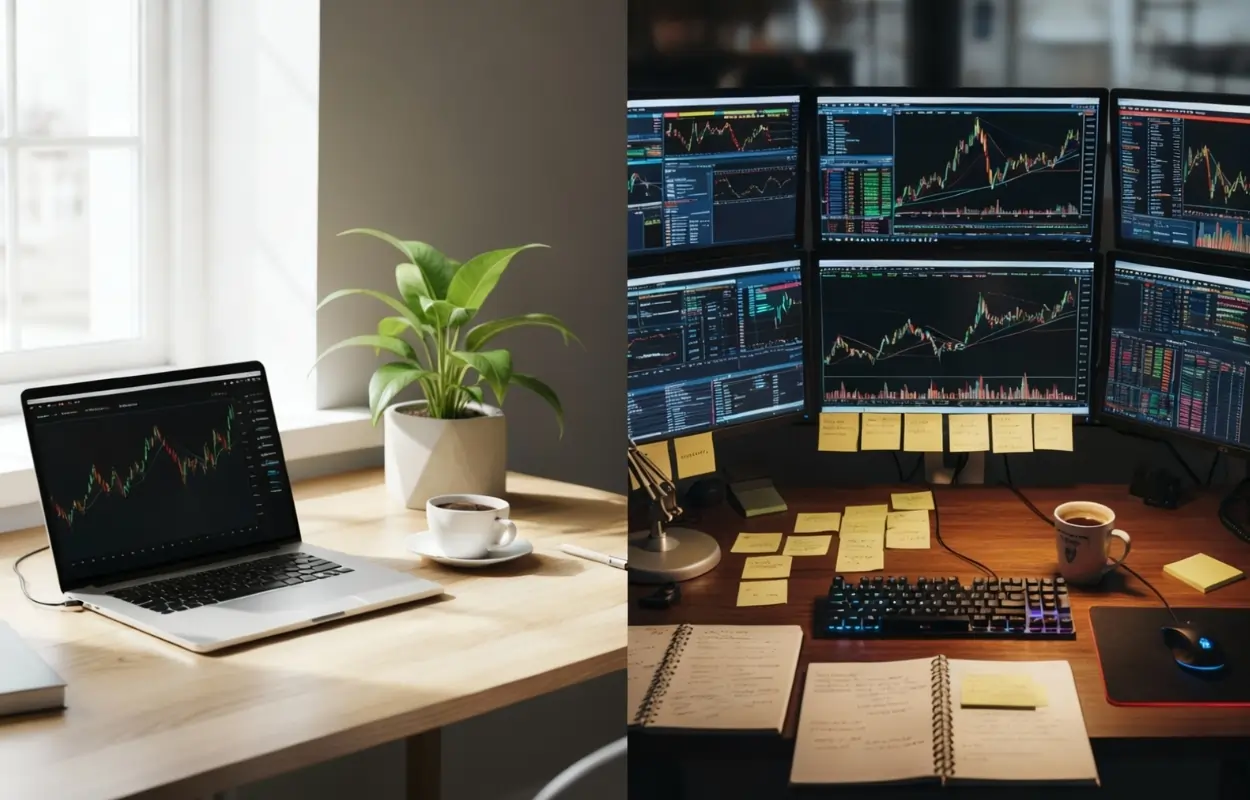A trader’s effectiveness is a direct function of their tools. Just as a master carpenter would not use a sledgehammer to craft a delicate piece of furniture, a trader must select a setup that aligns with their chosen trading style.
The high-velocity world of day trading and the more patient rhythm of swing trading demand distinctly different arsenals. While both disciplines share a common goal of profitability, the hardware, software, and analytical tools they employ are tailored to their unique time horizons and strategic needs.
The Day Trader’s Cockpit: Built for Speed and Data-Intensive Operations
The day trader’s environment is engineered for speed, reliability, and the capacity to process a massive amount of real-time information. The core of this setup is a high-performance computer. Because day trading involves making split-second decisions based on rapid price fluctuations, there is no room for technical lag or system failure.
A powerful central processing unit (CPU), such as a modern Intel Core i7 or AMD Ryzen 7, is essential for instantly executing orders and running complex analytical software. At least 16GB of RAM is considered the minimum to handle the demands of multiple applications running at once.
A multi-monitor display is not a luxury but a necessity. A typical day trading station will feature at least three screens, and often more. This allows a trader to view several critical pieces of information simultaneously:
- Charting software on a primary monitor, displaying price action across multiple timeframes.
- A Level 2 data feed on a second screen, showing real-time bid and ask orders.
- Financial news tickers and an economic calendar on a third, to stay abreast of market-moving events.
The choice of trading platform is equally critical. Day traders require a platform that offers Direct Market Access (DMA) for the fastest possible order execution. Features like one-click trading, customizable hotkeys, and advanced charting with a wide array of technical indicators are standard. The software must be robust and stable, as a platform crash during a live trade can be catastrophic.
Finally, a fast and reliable internet connection is non-negotiable. A hardwired, fiber-optic connection is strongly preferred over Wi-Fi to minimize latency, the small delay between when an order is placed and when it is executed.
An uninterruptible power supply (UPS) is also a wise investment, providing a battery backup to prevent a sudden power outage from disrupting a trading session.
The Swing Trader’s Workshop: Flexibility and Analytical Depth
The swing trader’s setup, while still professional, is generally less demanding in terms of raw hardware specifications. Because swing trading decisions are made over hours and days, the need for millisecond-level execution speed is less acute. A modern laptop or a well-configured desktop computer with a reliable processor and sufficient RAM (8GB is often adequate, though 16GB is better) is typically sufficient.
While a multi-monitor setup is still beneficial for analyzing charts and news, it is not as mission-critical as it is for a day trader. A swing trader might use a primary monitor for in-depth chart analysis and a secondary screen or a laptop to track a watchlist and read research reports.
The emphasis is less on processing a deluge of real-time data and more on conducting thorough analysis.
The choice of software for a swing trader is centered on analytical power and ease of use. Platforms like TradingView or MetaTrader 4 are popular choices, offering powerful charting packages, a vast library of technical indicators, and tools for backtesting strategies. Since trades are held for longer periods, mobile trading apps also play a more significant role, allowing a trader to monitor positions and make adjustments while away from their primary workstation.
The following table provides a clear comparison of the two setups:
| Feature | Day Trading Setup | Swing Trading Setup |
| Computer | High-end desktop with top-tier CPU and at least 16GB RAM. | Modern desktop or laptop with a solid processor and 8-16GB RAM. |
| Monitors | Three or more high-resolution monitors are standard. | One or two monitors are often sufficient. |
| Internet | High-speed, low-latency, hardwired connection is essential. | A stable broadband connection is adequate. |
| Software | Direct Market Access (DMA) platform with advanced order types and Level 2 data. | Charting-focused platform with strong analytical and backtesting tools. |
| Data Feeds | Real-time, tick-by-tick data is required. | End-of-day or slightly delayed data may be acceptable for some strategies. |
| Mobility | Primarily a stationary setup. | Can be more mobile, with a greater reliance on laptops and tablets. |
The Common Ground: A Foundation of Quality
Despite their differences, both day trading and swing trading setups are built on a common foundation of quality and reliability. In both disciplines, a trader’s tools must be dependable. A system crash, a data feed interruption, or a slow internet connection can be costly for any style of trader.
Furthermore, both types of traders benefit from clean, ergonomic workspaces. A comfortable chair, a keyboard and mouse that fit the hand well, and proper monitor positioning can reduce fatigue and improve focus during long hours of market analysis.
Ultimately, the choice of a trading setup is a personal one, dictated by the specific needs of the individual and their chosen strategy. The day trader builds a cockpit for high-speed maneuvering through volatile markets. The swing trader assembles a workshop for the patient and detailed construction of a trade. In both cases, the tools are not an afterthought. They are an integral part of the profession.
